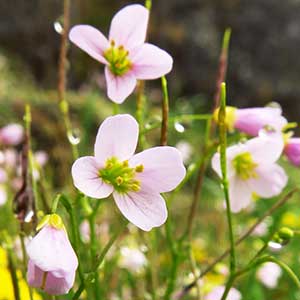Cardamine pattersonii
Cardamine occidentalis
Saddle Mountain bitter-cress
big western bitter-cress, western bitter-cress, western toothwort
cylindrical, slender, 0.5–1.5 mm diam.
(tuberiform, fragile), ovoid or globose at base of stem, 3–10 mm diam., (fleshy).
(simple from base), erect, (not flexuous), unbranched or branched basally, 0.6–3 dm.
(simple from base), erect to ascending, (not flexuous), unbranched or branched distally, 1–5 dm, glabrous or pubescent proximally.
rosulate or not, 3 or 5-foliolate, 1–6 cm, leaflets petiolulate;
petiole 0.4–2.5 cm;
lateral leaflets similar to terminal, considerably smaller;
terminal leaflet (petiolule 0.1–0.4 cm), blade obovate to orbicular or subcordate, 0.3–1.5(–2.0) cm × 2.5–16(–18) mm, base obtuse to rounded or cordate, margins entire or dentate to slightly sinuately lobed.
not rosulate, pinnately compound, (3 or) 5 (or 7)-foliolate, 2–10 cm, leaflets petiolulate or subsessile;
petiole 0.5–6.5 cm;
lateral leaflets petiolulate or subsessile, blade similar to terminal, ovate, smaller, margins entire;
terminal leaflet (petiolule 0.03–0.18 cm), blade orbicular to broadly ovate or subcordate, 0.5–2 cm × 7–25 mm, base cordate to rounded, margins entire or repand, (surfaces glabrous).
2–4, 3 or 5-foliolate, blade similar to basal, gradually reduced in size as bract, distalmost ones subtending pedicels of flowers (usually simple);
leaflet blade or bract linear to linear-oblanceolate, 0.2–0.8 cm.
3–7, (3 or) 5 or 7-foliolate (middle ones 5 or 7-foliolate, smaller distally, becoming 3-foliolate), petiolate;
petiole 0.5–3 cm, base not auriculate;
lateral leaflets similar to terminal, smaller;
terminal leaflet blade obovate to oblanceolate, 0.5–2.6 cm × 3–13 mm, margins shallowly toothed, entire, or repand.
bracteate throughout.
ebracteate.
sepals oblong, (2–)3 × 0.7(–1) mm, lateral pair not saccate basally;
petals purple or pink, obovate, 6–9 × 3–4 mm, (not clawed);
filaments: median pairs 3–3.5 mm, lateral pair 2–2.5 mm;
anthers oblong, 0.7–1 mm.
sepals oblong, 1.7–2 × 1–1.2 mm, lateral pair not saccate basally;
petals white, oblanceolate, 4–6 × 1.5–2 mm, (not clawed);
filaments: median pairs 2–2.5 mm, lateral pair 1–1.5 mm;
anthers ovate, 0.3–0.5 mm.
divaricate-ascending, (10–)15–30(–45) mm.
divaricate-ascending, 7–18 mm.
linear, (torulose), 2–3 cm × 1–1.5 mm;
ovules 14–20 per ovary;
style 2–4 mm.
linear, (torulose), 1.5–3.3 cm × 1.7–2.2 mm; (valves glabrous or sparsely pubescent);
ovules 18–40 per ovary;
style 0.5–1.5 mm.
brown, oblong to ovoid, 1.7–2.2 × 1–1.5 mm, (winged distally).
brown, ovoid, 1–1.6 × 1–1.2 mm.
= 64.
Cardamine pattersonii
Cardamine occidentalis
Of conservation concern.
Cardamine pattersonii is known from Saddle Mountain and Onion Peak in Clastop County.
(Discussion copyrighted by Flora of North America; reprinted with permission.)
- Local floras:
BC,
CA,
OR,
WA
- Local Web sites:
CalFlora,
CalPhotos,
Flora NW,
PNW Herbaria
WildflowerSearch
iNaturalist (observations)
USDA Plants Database
- LBJ Wildflower Center
- SEINet
- Plants of the World Online
- Encyclopedia of Life
- Wikipedia
- Google Image Search


